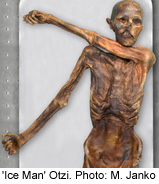
FRIDAY, Aug. 1, 2014 (HealthDay News) — Roaming the high Alps more than 5,000 years ago, the individual whose preserved mummy became famous as the “Ice Man” no doubt had a very tough and active lifestyle.
But all of that may still not have shielded the Ice Man, nicknamed Otzi, from a very modern scourge: heart disease.
A human’s genetic risk for atherosclerosis, or “hardening of the arteries,” appears to be the same today as it was thousands of years ago, a new study finds.
“Our ancestors going back thousands of years show signs of atherosclerosis,” explained a team led by author Albert Zink of the Institute for Mummies and the Iceman at the European Academy of Bolzano/Bozen in Italy.
The researchers noted that CT scans show “evidence of calcium deposits associated with atherosclerotic plaques in the arteries of mummies as old as 5,000 years. Even though our human ancestors lived far different lives than we do, their environments and lifestyles were not protecting them against the development of atherosclerosis.”
Modern advancements in imaging technology have identified clogged arteries in mummies of various cultures.
But were people living in ancient times also genetically predisposed to heart disease? Zink’s team explained that that’s been tough to discern because so much genetic material breaks down over centuries.
However, the whole-genome study of the 5,300-year-old glacier-bound Ice Man revealed the mummy was at a genetically increased risk for coronary heart disease.
Specifically, he had a certain genetic mutation that is considered to be one of the strongest genetic predictors of heart attacks, the research team said.
CT scans of the mummy also showed key warning signs of atherosclerosis, such as calcification in several major blood vessels. The study, scheduled for publication in the journal Global Heart, concluded that the Ice Man was genetically at risk for the condition because other known risk factors — such as being overweight, sedentary and smoking — were not relevant for people living in this time period.
However, “what is similar between now and then is the human genetic material,” the researchers wrote. They say they found genetic variations that work to “predispose the carrier to the development of atherosclerotic cardiovascular disease.”
Ancient people were also highly vulnerable to other illnesses, such as infectious diseases, nutritional deficiencies and trauma, the Italian group said in a news release from the World Heart Federation. These issues often caused their death before heart disease could impact their health, the researchers noted.
“Until now, the Ice Man is the only ancient human remain in which a genetic predisposition for cardiovascular disease has been detected,” Zink’s group said, but future work on remnants of DNA in other mummies might reveal just how widespread such vulnerabilities were.
More information
The American Heart Association has more about atherosclerosis.
Copyright © 2025 HealthDay. All rights reserved.

